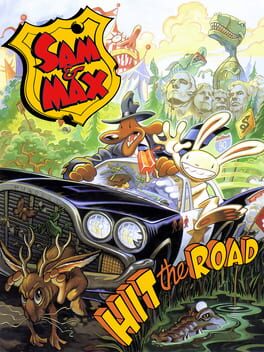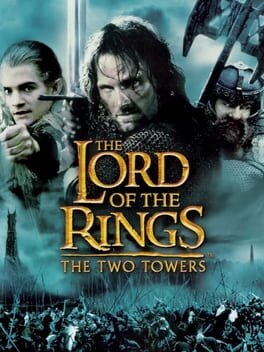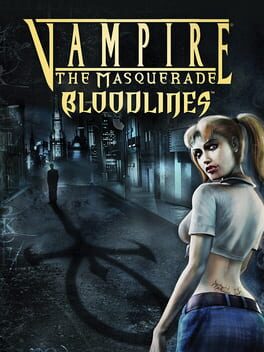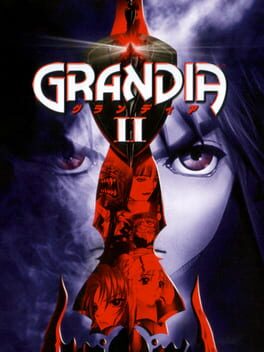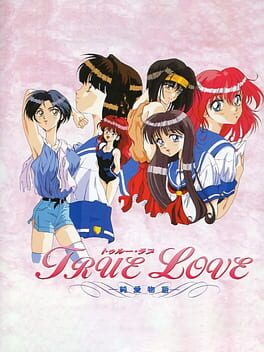sadstyle
Bio
shantytown's favorite son
shantytown's favorite son
Badges

1 Years of Service
Being part of the Backloggd community for 1 year
Favorite Games
003
Total Games Played
000
Played in 2024
000
Games Backloggd
Recently Reviewed See More
i dont want to give true love any semblance of prominence, importance, or significance. it's not a good game, but in the 90s up to the early 2000s, it was one of the few visual novels/dating sims you could get your hands on as a relatively naive yet enterprising adolescent trying to make sense of relationships, romance, and sex. i remember reading megatokyo as a 11 year old and being told by a thirty-something fred gallagher that games like kana: little sister and true love story were marvels of new media and were as engrossing and poignant as a traditional novel. i'm not sure if i feel that way outside of a handful of titles, but true love is not worth such consideration
developed by software house parsley, true love is a dating/life sim where you live as a near-destitute college student attempting to balance self-improvement, a job, and the affections of one of ten young ladies. on all fronts, this is another stat-building dating sim in the vein of something like tokimeki memorial or dokyusei, but with little to render it as memorable. if it weren't for the fact that true love was one of the first and few bishoujo games localized for the west at the time, it wouldn't nearly have the same distinction and fondness it experiences nowadays by fans of the genre. the production values for true love are also barely skirting the "budget" category and sinking into "complete destitution." TD-X, who i would assume as being parsley's art director at the time, was responsible for all art and graphic assets for this title. with how ambitious this game was in comparison to parsley's previous releases, corners had to be cut to maintain the production schedule. the art in this game is dated, sure, but its also not up to par with similar titles released earlier or around the same time. in terms of character design, many characters suffer from proportions that make you feel like you're romancing the primordial ooze that would birth the modern-day moeblob, and the "big eyes, small mouth" design philosophy behind many of these characters gets exaggerated to the point of near-parody.
the one thing that's truly outstanding, to me at least, would have to be the music tracks for this game. tracks are bubbly yet dense, and thoughtfully composed. i can only imagine what this must have sound like using something like a roland or yamaha sound module, rather than the generic Microsoft midi synth many probably played with. enterprising music producers should look at these tracks for inclusions in their sample library, or as composition studies. these are honestly some solid tracks.
there are some features of true love that are genuinely charming, but a lot of it comes from outside the game itself. the fact that it was translated and published in the west itself is notable, considering that game localization was still a relatively amateur practice among small publishers, and true love could be considered a behemoth containing over 2000 words of written dialogue (i believe?). the team at otaku publishing did a decent job adapting what was present and writing a script that was candid, fun, and palatable for its intended audience. the game's dialogue never takes itself too seriously, and it's to the game's benefit.
the game is also not an unadulterated smut fest, as one would assume, meaning that you have to spend time with these characters prior to any form of raunchy payoff. while there's way too much lazy writing present, and there's instances of sexual assault being used as a plot device, the game's storylines aren't completely offensive. there's complexity in how one should manage the affections of multiple suitors, and there's consequences for trying to play multiple prospects at once. some storylines (like ryoko's or chiemi's) are tender and sentimental, which should be the goal for a game like this.
true love can simply be seen as a poor reflection of its many contemporaries, but the game deserves some distinction for opening doors for a wider variety of japanese games in the market. if you really want to play something like this, go play tokimeki memorial or princess maker/long live the queen/palais de raine. if you absolutely need to play an eroge, play hoshi ori or something developed by elf or ASCII (to heart, clannad, etc). there's so many better options, and and the primary reason true love '95 should be treated with any particular fondness is because it opened the door for these games in the first place.
developed by software house parsley, true love is a dating/life sim where you live as a near-destitute college student attempting to balance self-improvement, a job, and the affections of one of ten young ladies. on all fronts, this is another stat-building dating sim in the vein of something like tokimeki memorial or dokyusei, but with little to render it as memorable. if it weren't for the fact that true love was one of the first and few bishoujo games localized for the west at the time, it wouldn't nearly have the same distinction and fondness it experiences nowadays by fans of the genre. the production values for true love are also barely skirting the "budget" category and sinking into "complete destitution." TD-X, who i would assume as being parsley's art director at the time, was responsible for all art and graphic assets for this title. with how ambitious this game was in comparison to parsley's previous releases, corners had to be cut to maintain the production schedule. the art in this game is dated, sure, but its also not up to par with similar titles released earlier or around the same time. in terms of character design, many characters suffer from proportions that make you feel like you're romancing the primordial ooze that would birth the modern-day moeblob, and the "big eyes, small mouth" design philosophy behind many of these characters gets exaggerated to the point of near-parody.
the one thing that's truly outstanding, to me at least, would have to be the music tracks for this game. tracks are bubbly yet dense, and thoughtfully composed. i can only imagine what this must have sound like using something like a roland or yamaha sound module, rather than the generic Microsoft midi synth many probably played with. enterprising music producers should look at these tracks for inclusions in their sample library, or as composition studies. these are honestly some solid tracks.
there are some features of true love that are genuinely charming, but a lot of it comes from outside the game itself. the fact that it was translated and published in the west itself is notable, considering that game localization was still a relatively amateur practice among small publishers, and true love could be considered a behemoth containing over 2000 words of written dialogue (i believe?). the team at otaku publishing did a decent job adapting what was present and writing a script that was candid, fun, and palatable for its intended audience. the game's dialogue never takes itself too seriously, and it's to the game's benefit.
the game is also not an unadulterated smut fest, as one would assume, meaning that you have to spend time with these characters prior to any form of raunchy payoff. while there's way too much lazy writing present, and there's instances of sexual assault being used as a plot device, the game's storylines aren't completely offensive. there's complexity in how one should manage the affections of multiple suitors, and there's consequences for trying to play multiple prospects at once. some storylines (like ryoko's or chiemi's) are tender and sentimental, which should be the goal for a game like this.
true love can simply be seen as a poor reflection of its many contemporaries, but the game deserves some distinction for opening doors for a wider variety of japanese games in the market. if you really want to play something like this, go play tokimeki memorial or princess maker/long live the queen/palais de raine. if you absolutely need to play an eroge, play hoshi ori or something developed by elf or ASCII (to heart, clannad, etc). there's so many better options, and and the primary reason true love '95 should be treated with any particular fondness is because it opened the door for these games in the first place.
it's hard to enjoy games based on third-party licenses and treat them seriously. still, stormfront studios earned the distinction of being one of few developers that could bank success on taking another entity's IP and creating something fun with it. in 1991, stormfront partnered with SSI (the developers of the goldbox games) and AOL to create neverwinter nights, arguably the first graphics-based MMO ever created. they would also develop titles in the Madden series for PC. so what does this have to do with twin towers for the ps2 then?
it may be hard to acknowledge, but gaming up until maybe the xbox 360 era consisted of franchise IPs sharing shelf space and legitimacy with first-party titles. while shovelware became synonymous with third-party games, you'd still have outstanding titles that showcased creativity and craftsmanship comparable to first-party developers. as we entered the 2000s, sterling examples of good third-party titles were few. however, the lord of the rings: the two towers showed that the right development team could make an impressive product that could occupy a unique space at the height and eventual decline of the game rental market, as well as provide the gamer on a budget with a solid contribution to their library. who could do this better than the studio that pioneered a new gaming genre nearly a decade earlier?
at first glance, the lord of the rings: the two towers doesn’t do much to distinguish itself from its siblings in the beat-em-up genre. for the ps2 at least, this game had to compete with god hand, viewtiful joe, devil may cry, crimson tears, and other games that emphasized stylish presentation alongside their well-refined, action-combat mechanics. however, there’s plenty to still appreciate about the twin towers, such as the game’s willingness to respect player autonomy by allowing for mechanics to be introduced and described diegetically. though this choice remains a rarity nowadays, consider the fact that it was 2002 and we were already getting to the point where text dumps and tutorials began creeping their way into a game’s first hour. the twin towers was also appropriately difficult, with amon hen and helm’s deep still being some of the most memorable objective-based missions i’ve played in a beat-em-up so far.
what i think is perhaps most notable about the lord of the rings: the two towers is the game’s pace and momentum. there isn’t much here to demand anything more than perhaps a 6 to 8 hour playthrough and that’s perfectly fine. it feels like the team at stormfront studios were acutely aware of this fact, ensuring that player skill would be the determining factor for the game’s length. there’s little bloat here, and the replayability comes from wanting to challenge yourself or unlock goodies because you’re a little tolkien freak. other than that, its just an extremely lean but satisfying experience, which is why the two towers was the ultimate video game rental title
consider that at this time, the market had variety when it came to consumer purchasing power. you could either buy the game at launch, buy the game used, rent the game, or borrow it from a friend. for those not able to justify a game purchase, rentals were a godsend for many during this generation. however, popular titles like final fantasy x, kingdom hearts, metal gear solid 2, or san andreas weren’t designed to be completed within the 2-3 day rental window that retailers like blockbuster or hollywood video gave to their customers. while risky, one could always go ahead and give the third-party titles a try, in the hopes that the developers weren’t ambitious and trying to do something artistic with the shark tale property. stormfront studios was ambitious though, but they were willing to design a game within the constraints of what the market expected from this kind of game which ultimately makes this title superb within its own little category.
no doubt that stormfront studios would take what they learned from making lord of the rings: the two towers and refine it for forgotten realms: demon stone, which some would argue to be a far more engrossing and fleshed-out game, but it’s still incredible to look back at this game and the time it came out as a unique period during gaming’s growing pains
it may be hard to acknowledge, but gaming up until maybe the xbox 360 era consisted of franchise IPs sharing shelf space and legitimacy with first-party titles. while shovelware became synonymous with third-party games, you'd still have outstanding titles that showcased creativity and craftsmanship comparable to first-party developers. as we entered the 2000s, sterling examples of good third-party titles were few. however, the lord of the rings: the two towers showed that the right development team could make an impressive product that could occupy a unique space at the height and eventual decline of the game rental market, as well as provide the gamer on a budget with a solid contribution to their library. who could do this better than the studio that pioneered a new gaming genre nearly a decade earlier?
at first glance, the lord of the rings: the two towers doesn’t do much to distinguish itself from its siblings in the beat-em-up genre. for the ps2 at least, this game had to compete with god hand, viewtiful joe, devil may cry, crimson tears, and other games that emphasized stylish presentation alongside their well-refined, action-combat mechanics. however, there’s plenty to still appreciate about the twin towers, such as the game’s willingness to respect player autonomy by allowing for mechanics to be introduced and described diegetically. though this choice remains a rarity nowadays, consider the fact that it was 2002 and we were already getting to the point where text dumps and tutorials began creeping their way into a game’s first hour. the twin towers was also appropriately difficult, with amon hen and helm’s deep still being some of the most memorable objective-based missions i’ve played in a beat-em-up so far.
what i think is perhaps most notable about the lord of the rings: the two towers is the game’s pace and momentum. there isn’t much here to demand anything more than perhaps a 6 to 8 hour playthrough and that’s perfectly fine. it feels like the team at stormfront studios were acutely aware of this fact, ensuring that player skill would be the determining factor for the game’s length. there’s little bloat here, and the replayability comes from wanting to challenge yourself or unlock goodies because you’re a little tolkien freak. other than that, its just an extremely lean but satisfying experience, which is why the two towers was the ultimate video game rental title
consider that at this time, the market had variety when it came to consumer purchasing power. you could either buy the game at launch, buy the game used, rent the game, or borrow it from a friend. for those not able to justify a game purchase, rentals were a godsend for many during this generation. however, popular titles like final fantasy x, kingdom hearts, metal gear solid 2, or san andreas weren’t designed to be completed within the 2-3 day rental window that retailers like blockbuster or hollywood video gave to their customers. while risky, one could always go ahead and give the third-party titles a try, in the hopes that the developers weren’t ambitious and trying to do something artistic with the shark tale property. stormfront studios was ambitious though, but they were willing to design a game within the constraints of what the market expected from this kind of game which ultimately makes this title superb within its own little category.
no doubt that stormfront studios would take what they learned from making lord of the rings: the two towers and refine it for forgotten realms: demon stone, which some would argue to be a far more engrossing and fleshed-out game, but it’s still incredible to look back at this game and the time it came out as a unique period during gaming’s growing pains

